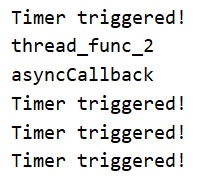libuv多线程简单应用示范
#include <stdio.h> #include <uv.h> // 声明回调函数 void asyncCallback(uv_async_t* handle); void thread_func_1(void *arg); void thread_func_2(void *arg); // 定时器回调函数 void timer_callback(uv_timer_t* handle) { // 定时器触发后执行的操作 printf("Timer triggered!\n"); fflush(stdout); } int main() { // 创建事件循环 uv_loop_t *loop = uv_default_loop(); // 创建线程 uv_thread_t thread_1, thread_2; if(uv_thread_create(&thread_1, thread_func_1, loop)) { printf("create thread1 fail!\n"); fflush(stdout); } if(uv_thread_create(&thread_2, thread_func_2, loop)) { printf("create thread2 fail!\n"); fflush(stdout); } // 等待线程执行结束 uv_thread_join(&thread_1); uv_thread_join(&thread_2); // 清理并关闭事件循环 uv_loop_close(loop); return 0; } // 实现回调函数 void asyncCallback(uv_async_t* handle) { printf("asyncCallback\n"); fflush(stdout); } void thread_func_1(void *arg) { uv_loop_t *loop_v = arg; uv_timer_t timer; // 初始化定时器句柄 uv_timer_init(loop_v, &timer); // 启动定时器 uv_timer_start(&timer, timer_callback, 0, 5000); // 每隔1s触发一次定时器 // 启动事件循环 uv_run(loop_v, UV_RUN_DEFAULT); printf("uv_run\n"); fflush(stdout); } void thread_func_2(void *arg) { uv_loop_t *loop_v = arg; // 定义异步处理器结构体 uv_async_t async; if(uv_loop_alive(loop_v)) { uv_async_init(loop_v, &async, asyncCallback); // 发送异步事件 uv_async_send(&async); } printf("thread_func_2\n"); fflush(stdout); }
注:uv_async_init()和uv_async_send()放在一个线程中
运行结果:



